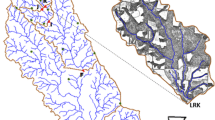Abstract
The Des Moines River that drains a watershed of 16,175 km2 in portions of Iowa and Minnesota is impaired for nitrate-nitrogen (nitrate) due to concentrations that exceed regulatory limits for public water supplies. The Soil Water Assessment Tool (SWAT) model was used to model streamflow and nitrate loads and evaluate a suite of basin-wide changes and targeting configurations to potentially reduce nitrate loads in the river. The SWAT model comprised 173 subbasins and 2,516 hydrologic response units and included point and nonpoint nitrogen sources. The model was calibrated for an 11-year period and three basin-wide and four targeting strategies were evaluated. Results indicated that nonpoint sources accounted for 95% of the total nitrate export. Reduction in fertilizer applications from 170 to 50 kg/ha achieved the 38% reduction in nitrate loads, exceeding the 34% reduction required. In terms of targeting, the most efficient load reductions occurred when fertilizer applications were reduced in subbasins nearest the watershed outlet. The greatest load reduction for the area of land treated was associated with reducing loads from 55 subbasins with the highest nitrate loads, achieving a 14% reduction in nitrate loads achieved by reducing applications on 30% of the land area. SWAT model results provide much needed guidance on how to begin implementing load reduction strategies most efficiently in the Des Moines River watershed.






Similar content being viewed by others
References
Arnold JG, Fohrer N (2005) SWAT2000: current capabilities and research opportunities in applied watershed modeling. Hydrological Processes 19:563–572
Arnold JG, Srinivasan R, Muttiah RS, Williams JR (1998) Large area hydrologic modeling assessment: Part 1 Model development. Journal of the American Water Resources Association 34(1):73–89
Benham BL, Baffaut C, Zeckoski RW, Mankin KR, Pachepsky YA, Sadeghi AM, Brannan KM, Soupir ML, Habersack MJ (2006) Modeling bacteria fate and transport in watershed models to support TMDLs. Transactions of the ASABE 49(4):987–1002
Borah DK, Yagow G, Saleh A, Barnes PL, Rosenthal W, Krug EC, Hauck M (2006) Sediment and nutrient modeling for TMDL development and implementation. Transactions of the ASABE 49(4):967–986
Chaplot V, Saleh A, Jaynes DB, Arnold JG (2004) Predicting water, sediment and NO3–N loads under scenarios of land-use and management practices in a flat watershed. Water, Air and Soil Pollution 154:271–293
Gassman PW, Reyes M, Green CH, Arnold JG (2007) The soil and water assessment tool: historical development, applications, and future directions. Transactions of the ASABE 50(4):1211–1250
Howden NJK, Bowes MJ, Clark ADJ, Humphries N, Neal (2009) Water quality, nutrients and the European union’s Water Framework directive in a lowland agricultural region: Suffolk, south-east England. Science of the Total Environment 407:2966–2979
Hu X, McIsaac GF, David MB, Louwers CAL (2007) Modeling riverine nitrate export from an east–central Illinois watershed using SWAT. Journal of Environmental Quality 36:996–1005
Iowa Department of Natural Resources (IDNR) (2004) 2002 Impaired waters list. Iowa Department of Natural Resources, Des Moines, IA
Jha M, Gassman PW, Arnold JG (2007) Water quality modeling for the Raccoon River Watershed using SWAT. Transactions of the ASABE 50(2):479–493
Kalita PK, Algoazany AS, Mitchell JK, Cooke RAC, Hirschi MC (2006) Ssubsurface water quality from a flat tile-drained watershed in Illinois, USA. Agriculture Ecosystems & Environment 115:183–193
Moriasi DN, Arnold JG, Van Liew MW, Binger RL, Hermel RD, Veith T (2007) Model evaluating guidelines for systematic quantification of accuracy in water simulations. Transactions of the ASABE 50(3):885–900
Nash JE, Sutcliffe JV (1970) River flow forecasting through conceptual models: Part 1. A discussion of principles. Journal of Hydrology 10(3):282–290
Neitsch SL, Arnold JG, Kiniry JR, Williams JR (2005a) Soil and water assessment tool theoretical documentation, Version 2005. USDA-ARS Grassland, Soil and Water Research Laboratory, Temple, TX. http://www.brc.tamus.edu/swat/doc.html, retrieved 25 October 2007
Neitsch SL, Arnold JG, Kiniry JR, Srinivasan R, Williams JR (2005b) Soil and water assessment tool input/output file documentation, Version 2005. USDA-ARS Grassland, Soil and Water Research Laboratory, Temple, TX. http://www.brc.tamus.edu/swat/doc.html, retrieved 25 October 2007
Pieterse NM, Bleuten W, Jorgensen SE (2003) Contribution of point and diffuse sources to nitrogen and phosphorus loads in lowland river tributaries. Journal of Hydrology 271:213–225
Prior JC (1991) Landforms of Iowa. University of Iowa Press, Iowa City, Iowa, p 154
Santhi C, Arnold JR, Williams JR (2001) Application of a watershed model to evaluate management effects on point and nonpoint source pollution. Transactions of the ASABE 44:1559–1570
Sawyer J, Nafziger E, Randall G, Bundy L, Rehm G, Joern B (2006) Concepts and rationale for regional nitrogen rate guidelines for corn. PM 2015. Iowa State University Extension, Ames, IA
Schilling KE, Wolter CF (2009) Water quality improvement plan for the Des Moines River, Iowa: total maximum daily load for nitrate. Iowa Department of Natural Resources, Des Moines, IA, p 96
Schilling KE, Jha MK, Zhang YK, Gassman PW, Wolter CF (2008) Impact of land use and land cover change on the water balance of a large agricultural watershed: historical effects and future directions. Water Resources Research 44, W00A09. doi:10.1029/2007WR006644
Tomer MD, Meek DW, Jaynes DB, Hatfield JL (2003) Evaluation of nitrate-nitrogen fluxes from a tile-drained watershed in central Iowa. Journal of Environmental Quality 32:642–653
United States Environmental Protection Agency (USEPA) (1993) Nitrogen Control Manual: Office of Research and Development, EPA625/R93/010. US Government Printing Office, Washington DC
United States Environmental Protection Agency (USEPA) (2009) National Summary of Impaired Waters and TMDL Information. Available at http://iaspub.epa.gov/waters10/attains_nation_cy.control?p_report_type=T#causes_303d. Accessed 19 August 2009
Van Liew MW, Arnold JG, Bosch DD (2005) Problems and potential of autocalibrating a hydrologic model. Transactions of the ASABE 48(3):1025–1040
Walter T, Dosskey M, Khanna M, Miller J, Tomer M, Wiens J (2007) The science of targeting with landscapes and watersheds to improve conservation effectiveness. In: Schnepf M, Cox C (eds) Managing agricultural landscapes for environmental quality strengthening the science base. Soil and Water Conservation Society, Washington, DC, pp 63–90
Author information
Authors and Affiliations
Corresponding author
Rights and permissions
About this article
Cite this article
Schilling, K.E., Wolter, C.F. Modeling Nitrate-Nitrogen Load Reduction Strategies for the Des Moines River, Iowa Using SWAT. Environmental Management 44, 671–682 (2009). https://doi.org/10.1007/s00267-009-9364-y
Received:
Revised:
Accepted:
Published:
Issue Date:
DOI: https://doi.org/10.1007/s00267-009-9364-y




